Blended Learning | Teaching Strategies
How To Use AES for In-Person, Remote, and Hybrid Learning Situations
Coming from a family of educators, Brad knows both the joys and challenges of teaching well. Through his own teaching background, he’s experienced both firsthand. As a writer for iCEV, Brad’s goal is to help teachers empower their students by listening to educators’ concerns and creating content that answers their most pressing questions about career and technical education.
Teaching today is surrounded by a shroud of uncertainty. Many schools switch between daily in-person instruction and remote learning, while others adopt a hybrid model. Some institutions have needed to change their instructional setting quickly and without warning.
As a teacher, the rapid change between in-class, remote, and hybrid instruction can leave you scared and scrambling. How will you keep your students learning?
Because of this, teachers ask us for clarity to understand if AES is a good fit for their situation and how they could use it when transitioning between scenarios.
In this article, you’ll discover best practices and examples of how teachers like you make the most of AES when teaching in your unique situation.
Click below to jump to the information relevant to you:
- An Overview of the AES Curriculum Structure and Available Resources
- How To Use AES for In-Person Instruction
- How to Use AES for Remote Learning
- How to Use AES for Hybrid Learning
After reading this post, you should better understand how to get the most out of AES in your particular teaching situation.
An Overview of the AES Curriculum Structure and Available Resources

The AES curriculum is designed for blended learning and divided into groups of related units, lessons, and activities called modules. Every module is organized according to our unique learning plan called the Four Phases.
The four phases of the AES curriculum are:
- Explore - Students discover a concept through instructor-led activities.
- Learn & Practice - Students learn through teacher-led and eLearning lessons.
- Reflect - Teacher-led activities help students review and discuss key ideas.
- Reinforce - Students complete projects that enhance their understanding of concepts and skills.
Across the phases, you’ll find blended learning materials to reach students through both traditional classroom learning and digital components.
This unique combination allows students to partake in active learning activities that maximize their ability to retain and understand information and grow in your class.
The AES curriculum structure allows flexibility for teachers no matter what their situation is.
How To Use AES for In-Person Instruction

If you're teaching full-time, in-person classes the AES blended learning system can be a great resource for you and your students. This way, your students will get the most out of your unique presence and energy as a teacher while learning with their peers in class discussions, projects, and other activities.
When you see your students in class daily, you can use elements of the four phases of learning designed specifically for in-person learning alongside the eLearning components that help teach and strengthen your learners’ understanding.
In this section, you’ll find how to use each phase of the AES curriculum when teaching in-person classes.
 Using the Explore Phase for In-Person Instruction
Using the Explore Phase for In-Person Instruction
Since the Explore phase includes discussion questions intended to get students excited and thinking about a new topic, they’re perfect for fostering class-wide conversations or small group discussions.

You can use the Explore phase activities to inspire learning through resources such as role-play scripts, equipment demonstrations, and other introductory activities.
The introductory aspect of these activities makes them an excellent icebreaker for kicking off a new topic in your class.
You can also use Explore phase activities to transition between module topics or as a break for students during instructional periods. When you end one learning module and plan to jump into a new module, it can be tempting to tell students to go straight into the next set of eLearning lessons.
However, getting your students away from their screens and doing an Explore activity from the next module is a great way to mix things up and indicate that you are moving on to a new topic.
Engaging your students with these activities can help them prepare for the Learn & Practice phase.
 Using the Learn & Practice Phase for In-Person Instruction
Using the Learn & Practice Phase for In-Person Instruction
The Learn & Practice phase is where the core instruction takes place in a learning module. Here, students experience new material through both teacher-led classroom instruction and digital lessons.
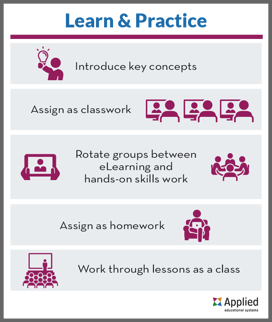
There are five common ways teachers use the Learn & Practice phase in their classes:
- Introduce key concepts with an in-class lecture
- Assign eLearning lessons as classwork
- Rotate groups between eLearning and hands-on skills work
- Assign eLearning lessons as homework
- Work through the lessons as a class
The presentation slides are perfect for teaching your students during class time.
Corresponding eLearning lessons and student worksheets can be used in class or assigned as homework. In addition, you can use formative unit quizzes and summative assessments to check student progress and understanding.
The digital components of AES give you the flexibility to assign them to students when it makes sense in your regular classroom instruction.
 Using the Reflect Phase for In-Person Instruction
Using the Reflect Phase for In-Person Instruction
Once students have completed the Learn & Practice phase, the Reflect phase is your chance to check their understanding through engaging, teacher-led discussions and activities.
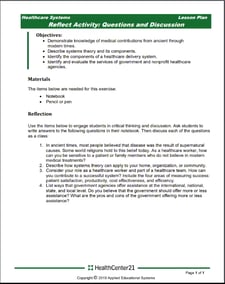 In the Reflect phase, you’ll find lesson plans with 4-5 question prompts you can use to help students see the big picture.
In the Reflect phase, you’ll find lesson plans with 4-5 question prompts you can use to help students see the big picture.
Teachers use these Reflect phase activities in three ways:
- Assign student journals
- Host a classroom discussion
- Create short essay questions for an assessment
When using these activities, keep in mind that you don’t have to use them for every module. Regardless of how you employ the Reflect phase activities, they can help students better comprehend course material by engaging with the material and others in the class.
 Using the Reinforce Phase for In-Person Instruction
Using the Reinforce Phase for In-Person Instruction
The Reinforce phase serves as a summation of a student’s learning in a module. The learner-led projects, activities, and presentations in the Reinforce phase allows students to demonstrate their knowledge individually and as a class.
You’ll find that some activities are more appropriate for students to work on individually, such as filling out a questionnaire, completing an activity sheet, or practicing skills.
Others can be assigned as group work, such as those that involve role-play scenarios or creating posters.
You can assign Reinforce phase projects individually as classwork or homework. You can use class time for collaborative exercises to help students interact and grow their understanding by working together.
When working together and experiencing each others’ projects in the Reinforce phase, your learners will arrive at a more complete appreciation of a subject that will serve as a foundation for future learning.
How To Use AES for Remote Learning

While the AES blended learning system wasn’t designed for strictly remote or distance learning, sometimes things happen that are out of your control, and you may need to teach remotely for a time. Hurricanes, snow days, and unexpected building closures can all force you to adjust your lesson plans. In these situations, it’s possible to adapt AES for remote learning.
Below, you’ll learn how you can successfully use the AES curriculum when teaching remotely.
Using the Explore Phase for Remote Learning
The activities in the Explore phase go a long way in introducing your students to the content in an AES learning module. The discussions with your students here can help open their minds to comprehending new concepts and ideas and make them ready for the content they will learn in the Learn & Practice phase.
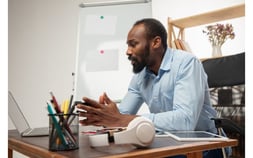 When you need to teach remotely for a time, you can use technology to facilitate class discussions.
When you need to teach remotely for a time, you can use technology to facilitate class discussions.
By turning the Explore phase discussion questions into an online discussion board, you can provide an outlet for students to think critically about each question.
Using a discussion board can ensure that each learner is participating and easily track students who aren’t completing their assignments and falling behind.
You can also introduce Explore phase questions during remote class video lectures, encouraging students to interact with each other in these warm-up activities.
Using the Learn & Practice Phase for Remote Learning
Because the Learn & Practice phase involves instructional components within the AES digital learning system, it’s one of the easiest to adapt to fully remote learning.
To start, you can use the included teacher PowerPoint presentations during your virtual class time to introduce students to the content in a module or unit. This way, you can use the same AES instructional materials you would use for in-person lessons but simply move them to a virtual setting.
After your class presentations, students can complete the eLearning components within the digital curriculum system. Distance learning can allow students to complete their assignments either at their own pace or at a designated time in your virtual instructional period.
To help your students learn digitally, we recommend turning on electronic worksheets to fill out as they go through the content. These worksheets will provide an additional touchstone for students to connect with the content and understand the course material better.
Using the Reflect Phase for Remote Learning
After completing instruction in the Learn & Practice phase, the Reflect phase allows teachers to review students’ comprehension. This is particularly critical when students are learning remotely because it allows you to check their understanding even from a distance.
The Reflect phase features lesson plans with about 4-5 question prompts that you can use to lead students in a discussion or as a form of student assessment.
To adapt the Reflect phase to remote learning, turn the discussion questions into an online board where learners can interact, answer questions and short essay prompts, and comment on each other’s responses. This digital conversation can go a long way in making sure students continue to engage with the material.
Using the Reinforce Phase for Remote Learning
Finally, the Reinforce phase is your students’ opportunity to demonstrate their understanding through individual and small group activities. While distance learning can sometimes make collaboration more complicated, it’s important that your students still have the opportunity to interact with one another when working remotely.
Depending on the activities in each module, you can use several teaching methods when implementing the Reinforce phase remotely.
For individual activities, students can work on projects at their own pace. When they are complete, you can have them present their work to the class or turn it in electronically. Students can also record and share presentations virtually.
 For small group projects and presentations, you can instruct learners to collaborate through breakout video groups or meet on their own to complete assignments. Group representatives can then present their results during virtual instructional time.
For small group projects and presentations, you can instruct learners to collaborate through breakout video groups or meet on their own to complete assignments. Group representatives can then present their results during virtual instructional time.
Regardless of the activity, it’s possible to adapt Reinforce phase projects to cement student comprehension while learning remotely.
How To Use AES for Hybrid Learning

Instead of fully in-person or remote education, many schools are turning to hybrid learning solutions to ensure students experience the benefits of digital instruction and classroom interaction with their peers.
Since AES is a blended learning resource, you can quickly adapt it for hybrid learning situations. Whether your school switches between remote and in-person instruction on a regular schedule or changes unexpectedly, the flexibility of using AES allows you to be ready for however you are teaching your students.
In this section, you’ll learn how you can get the most out of AES in a hybrid instructional setting.
Using the Explore Phase for Hybrid Learning
Knowing which days your students will be working remotely and when they’ll be coming to class in person makes it easy to plan your instruction around your students’ expected schedule.
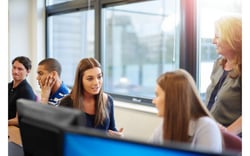 The Explore phase activities are great for in-person discussions to open the dialogue around a new subject.
The Explore phase activities are great for in-person discussions to open the dialogue around a new subject.
Having these conversations in class helps students feel more comfortable thinking about a new topic before diving into eLearning lessons, which they can complete remotely.
An alternative is having students complete the discussion questions on an online board before coming to class. Then, you can review the board and provide clarity to your learners before moving forward. Once everyone is on the same page, your students are ready to dive into the Learn & Practice phase.
Using the Learn & Practice Phase for Hybrid Learning
Because AES employs a blended learning strategy with both traditional and digital instructional components, you can easily divide these two teaching methods between in-person and remote work.
The teacher-led resources in the Learn & Practice phase, such as the presentation slides, are perfect for when students are attending your class in person. This way, it’s easy to make sure students are engaged and to check their understanding.
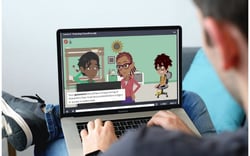 On days when students are working remotely, eLearning lessons in the AES system provide them with engaging instruction and progress checks even from a distance.
On days when students are working remotely, eLearning lessons in the AES system provide them with engaging instruction and progress checks even from a distance.
You can also assign unit quizzes to be completed remotely through AES while reserving module tests for class time.
Using the Reflect Phase for Hybrid Learning
The Reflect phase is your opportunity to check how well your students have retained the knowledge they’ve gathered during the Learn & Practice phase. Typically, the Reflect phase includes 4-5 question prompts that you can use in several different ways
You can adapt these discussion questions and short essay prompts for hybrid learning by instructing students to complete these prompts outside of class. This will allow them to reflect on what they have discovered during the Learn & Practice phase before contributing to a class discussion.
When students are in class, you can review their short essay responses and lead your learners in a conversation surrounding other discussion questions. This way, you can make sure everybody is on board and has the chance to interact with others’ ideas.
Using the Reinforce Phase for Hybrid Learning
Finally, the Reinforce phase offers ample occasion for learners to complete projects and activities both in-person and remotely.
When working remotely, it’s easy to assign students individual projects that they can complete at home at their own pace. This way, you’ll give your students flexibility in how they organize their study time while reserving your precious class time for collaborative activities.
Since small group projects are most successful when students can communicate face-to-face, consider reserving class time for students to collaborate.
You’ll give them yet another opportunity to learn from one another and demonstrate their understanding of the subject matter.
Ready to Take the Next Step in Teaching with AES?
Today’s students are experiencing school in different and often unexpected ways. As a teacher, you can easily be overwhelmed when your institution switches from in-person, remote, hybrid instruction, often with little warning or guidance on how to ensure your students will be successful. In these situations, it’s easy to feel helpless and scared.
Thankfully, because AES is a blended learning solution, you can be prepared for whichever way you need to teach next.
Since AES works best when students can experience in-person instruction while completing eLearning elements, you can easily assign digital components for distance learning days if your school is running on a hybrid schedule. Even when fully remote, it’s possible to adapt each of the four phases of AES to make sure your students never stop learning.
If you’re a current AES customer, consider joining the AES Educator Community to connect with other teachers for support, ideas, and inspiration.
If you’re new to AES and are curious about how you can implement blended learning into your CTE program, sign up for your free trial today. When you sign up for a trial, you’ll have full access to the AES curriculum resources to help you decide if it’s right for you.
.png)

